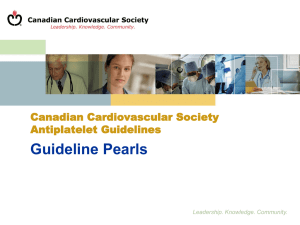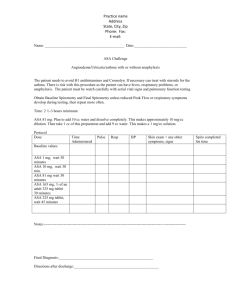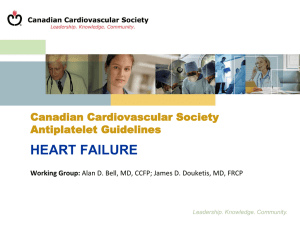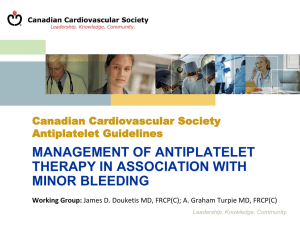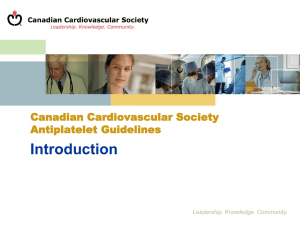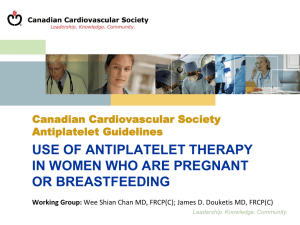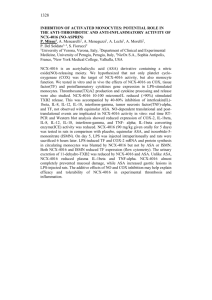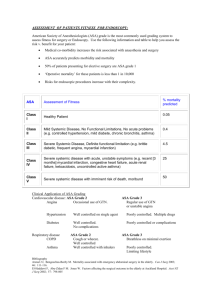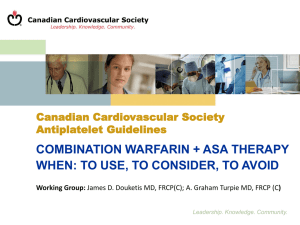CCS Guideline on Antiplatelet Therapy for
advertisement
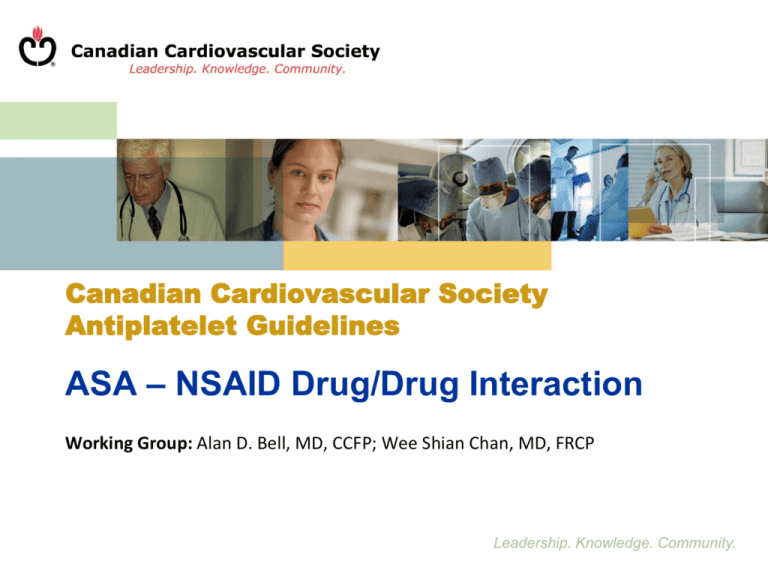
Canadian Cardiovascular Society Antiplatelet Guidelines ASA – NSAID Drug/Drug Interaction Working Group: Alan D. Bell, MD, CCFP; Wee Shian Chan, MD, FRCP Leadership. Knowledge. Community. Objectives Interpret the Canadian Cardiovascular Society Guideline recommendations regarding the use of antiplatelet therapy in patients taking Non-Steroidal Anti-Inflammatory Drugs. Recognize how traditional NSAID and Coxibs affect platelet function. Identify the drug interaction between NSAID and ASA. Evaluate the evidence regarding the clinical effect of the concomitant use of NSAID and ASA. © 2011 - TIGC George George, a 64 year old male is in your office complaining of L knee pain of 8 months duration. History, physical exam and X-rays of the knee indicate a diagnosis of osteoarthritis. He notes some improvement with the use of OTC ibuprofen. He has a past history of: Coronary artery disease, with NSTEMI 3 years prior Hypertension Hyperlipidemia GERD Current medications include: ASA 81 mg OD Atenolol 50 mg OD Ramipril 10 mg OD Hydrochlorothiazide 12.5 mg OD Atorvastatin 40 mg OD Omeprazole 20 mg OD © 2011 - TIGC Polling question Other than physical measures and intra-articular steroid, how would you manage George’s knee OA pain? A. Analgesics followed by traditional NSAID if required B. Analgesics followed by Coxib if required C. Analgesics only. I would avoid the use of traditional NSAID and Coxibs. © 2011 - TIGC Prostaglandin biosynthesis Arachidonic Acid (+) Laminar Shear Stress Inflammatory (+) cytokines COX-2 (inducible) COX-1 (constitutive) Homeostatic PG Stomach Intestine Kidney Platelet (–) NSAIDs Inflammatory PG Arthritis (–) COX-2 specific inhibitors Prostacyclin Anti-thrombosis © 2011 - TIGC Arachidonic Acid ASA X Platelet COX-1 X Thromboxane Although it has a short serum half life, ASA forms permanent covalent bond to platelet COX-1 halting thromboxane synthesis. X Traditional NSAID Forms weak temporary bond to platelet COX-1 blocking ASA binding © 2011 - TIGC Arachidonic Acid Platelet COX-1 Platelet activation Thromboxane When serum levels of traditional NSAID fall, platelet becomes active again. © 2011 - TIGC ASA NSAID platelet interaction Inhibition of Platelet COX-1 by ASA Measured 24 Hours Post ASA ASA Pre-treatment Alone with ibuprofen Pre-treatment with diclofenac or rofecoxib 0 % inhibition Thromboxane B2 Platelet aggregation 100 Catella-Lawson F et al. N Engl J Med 2001;345:1809-17. © 2011 - TIGC ASA NSAID Interaction • Observational study • n=7,107 post CV event discharge 100 Proportion surviving (%) 90 • Ibuprofen users had a significantly increased risk of CV and all-cause mortality compared to ASA alone 80 70 60 50 40 ASA alone ASA + diclofenac ASA + other NSAIDs ASA + ibuprofen 30 20 10 0 0 1 2 3 4 5 Follow-up (year) MacDonald TM, Wei L. Lancet 2003;361:573-4. p=0.03 vs. ASA 6 7 8 9 Aspirin, NSAIDs and risk of myocardial infarction USPHS, n=22,071 Follow up 60 months Placebo vs ASA 325mg q2d (44% MI reduction) NSAID use: None 1-59 days per year > 60 days per year Circulation. 2003;108:1191-1195 © 2011 - TIGC MI and NSAID use in ASA users from USPHS GROUP ASA PLACEBO 1 1 < 59 days 1.18 1.17 > 60 days NS 2.81 NS 0.21 P<0.05 NS NSAID USE None Circulation. 2003;108:1191-1195 © 2011 - TIGC TARGET Composite cardiovascular outcomes in the ibuprofen sub-study of high-risk patients Composite cardiovascular outcomes* Lumiracoxib (%) Ibuprofen (%) p No aspirin Low-dose aspirin Overall 0.92 0.80 NS 0.25 2.14 0.03 0.56 1.61 0.05 *Composite end point includes nonfatal and silent MI, stroke, and cardiovascular death . Ann Rheum Dis. 2007 Jun;66(6):764-70 Total TARGET population n=18,325 High C/V Risk population n=3042 Ibuprofen substudy n=1343 Naproxen substudy n=1699 © 2011 - TIGC TARGET Composite cardiovascular outcomes in the naproxen sub-study of high-risk patients Composite cardiovascular outcomes* Lumiracoxib (%) Naproxen (%) p No aspirin Low-dose aspirin 1.57 1.48 0 1.58 0.02 NS Overall 1.51 0.95 NS *Composite end point includes nonfatal and silent MI, stroke, and cardiovascular death . Total TARGET population n=18,325 High C/V Risk population n=3042 Ibuprofen substudy n=1343 Naproxen substudy n=1699 © 2011 - TIGC Ann Rheum Dis. 2007 Jun;66(6):764-70 Naproxen effect Like other traditional NSAIDs, naproxen competes with ASA to bind COX-1. Although it has a stronger antiplatelet effect than other NSAID it remains a reversible inhibitor. Clinical benefit of naproxen in prevention of CV events is not established. May be the best choice if a traditional NSAID is absolutely needed. © 2011 - TIGC Do Coxibs interfere with ASA cardioprotection? A new cyclooxygenase-2 inhibitor, rofecoxib (VIOXX), did not alter the antiplatelet effects of low-dose aspirin in healthy volunteers. [J Clin Pharmacol. 2000] PMID: 11185674 Celecoxib, ibuprofen, and the antiplatelet effect of aspirin in patients with osteoarthritis and ischemic heart disease. [Clin Pharmacol Ther. 2006] PMID: 16952493 The COX-2 selective inhibitor, valdecoxib, does not impair platelet function in the elderly: results of a randomized, controlled trial. [J Clin Pharmacol. 2003] PMID: 12751271 Lumiracoxib does not affect the ex vivo antiplatelet aggregation activity of low-dose aspirin in healthy subjects. [J Clin Pharmacol. 2005] PMID: 16172182 Celecoxib does not affect the antiplatelet activity of aspirin in healthy volunteers. [J Clin Pharmacol. 2002] © 2011 - TIGC Risk estimate for hospitalization for MI for NSAID Users compared with non-users Case control study of 10,280 MI events Adjusted Relative Risk 95% CI Rofecoxib 1.80 1.47-2.21 Celecoxib 1.25 0.97-1.62 COX-2 “selective” agents* 1.45 1.09-1.93 Naproxen 1.50 0.99-2.29 Other NSAIDs 1.68 1.52-1.85 High-dose ASA 1.34 1.18-1.52 Drug *Etodolac, meloxicam, nabumatone © 2011 - TIGC Arch Intern Med. 2005;165:978-984. Risk of AMI and SCD with current use of COX-2 celective and NS-NSAIDs Case-control observational study (1.4 m from Kaiser data) P<0.01 Adjusted† Odds Ratio (95% CI) 3.5 3.15 (1.14-8.75) 3.0 2.5 P=0.06 P=0.01 2.0 1.5 1.0 1.09 1.00 0.86 (0.99-1.21) (reference) (0.69-1.07) P<0.01 1.29 1.18 (0.93-1.79) (1.04-1.35) P=0.005 1.33 1.16 (1.09-1.63) (1.04-1.30) 1.69 (0.97-2.93) 0.5 0.0 Control Celecoxib (remote use) Ibuprofen Naproxen Rofecoxib 25 mg Rofecoxib >25 mg Other Indomethacin Diclofenac NSAIDs †Adjusted for age, gender, health plan region, medical history, smoking, and medication use. © 2011 - TIGC Lancet. 2005;365:475-81. Systematic review of observational studies RR of CV event * * * * p < 0.05 JAMA. 2006 Oct 4;296(13):1633-44 © 2011 - TIGC Meta analysis of randomized controlled trials of CV events in NSAID users 1,8 1,6 1,4 RR of CV event 1,2 1 0,8 0,6 0,4 0,2 0 Coxib Ibu BMJ. 2006 Jun 3;332(7553):1302-8. Diclo Nap © 2011 - TIGC George The patient is advised to avoid the use of OTC ibuprofen due to the well established adverse drug interaction with ASA. He is advised to use acetaminophen in doses up to 2 – 4 grams/day. If acetaminophen fails other interventions should be attempted including: Physiotherapy Intra-articular steroid Surgery Higher potency analgesics If these fail or are inappropriate, a coxib may be tried with monitoring of BP, renal function and hemoglobin. © 2011 - TIGC Interaction between Acetylsalicylic Acid and Nonsteroidal Anti-inflammatory Drugs RECOMMENDATIONS Working Group: Alan D. Bell, MD, CCFP Wee Shian Chan, MD, FRCP Leadership. Knowledge. Community. 22 ® Interaction between acetylsalicylic acid and nonsteroidal anti-inflammatory drugs 1. Individuals taking low-dose ASA (75-162 mg daily) for vascular protection should avoid the concomitant use of traditional (noncoxib) NSAIDs (Class III, Level C). 2. If a patient taking low-dose ASA (75-162 mg daily) for vascular protection requires an anti-inflammatory drug, specific cyclooxygenase-2 inhibitors (coxibs) should be chosen over traditional NSAIDS (Class IIb, Level C). 3. Both coxib and traditional NSAIDs increase cardiovascular risk and if possible, should be avoided in patients at risk of ischemic vascular events (Class III, Level A). 23 ® Interaction between acetylsalicylic acid and nonsteroidal anti-inflammatory drugs What if… GEORGE HAS A CONTRAINDICATION FOR COXIBS, BUT NEEDS AN NSAID? © 2011 - TIGC “What if” If a traditional NSAID is required, some evidence suggests that naproxen may be the best choice due to it’s more potent antiplatelet effect. It should be used in combination with gastroprotection either a PPI or misoprostol. Blood pressure, hemoglobin and renal function should be monitored. © 2011 - TIGC © 2011 - TIGC
